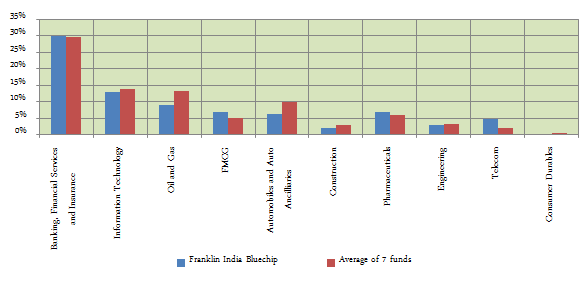Investing in too many Mutual Fund Schemes of similar type does not help

Mutual funds are wonderful investment options for meeting a variety of financial goals. However, a common problem which retail investors often face is the problem of too many choices. One of main advantages of mutual fund investment is that retail investors can achieve risk diversification because mutual funds invest in a broad range of securities which limits investment risk associated with specific securities. Some investors invest in multiple mutual funds to achieve further diversification. However, investing in a large number of funds may not serve the objective of achieving optimal diversification. This is especially true if the funds in the investor’s portfolio are of the same type. Mutual funds of the same type often invest in more or less the same set of securities. Even the sector allocation of their portfolios may not be very different from each other.
In this article, we will examine the portfolio composition of some very well know large cap funds. We will analyze if investors can achieve optimal portfolio risk diversification spread their investment across a large number of these funds. The funds that we have selected for our analysis are:-
- Franklin India Bluechip fund
- HDFC Top 200 fund
- ICICI Prudential Focused Bluechip Equity fund
- L&T Equity fund
- UTI Equity fund
- ICICI Prudential Top 100 fund
- SBI Magnum Equity fund
All these funds are very well known funds, each with several thousands of crores of assets under management. All these funds have delivered good performance at various points of time. Let us analyze the sector allocation of the funds’ portfolios. For our analysis, we have chosen the top 10 sectors, which account for over 80% of the funds’ portfolios. These sectors are
- Banking, Financial Services and Insurance (BFSI)
- Information Technology
- Oil and Gas
- FMCG
- Automobiles and auto ancillaries
- Construction
- Pharmaceuticals
- Engineering
- Consumer Durables
The table below shows the sector allocation of the funds mentioned above.

We can see that the distribution of sector weights in these portfolios is within a limited range, barring a few exceptions. Let us now analyze, if you had split your investment in equal amounts in all the seven funds, how would your sector allocation be different compared to investment in a single fund, say the Franklin India Bluechip fund. The chart below shows the sector allocation of Franklin India Bluechip fund and average sector allocation of all the seven funds.

We can see that if you had split your investment in equal amounts in all the seven funds, your sector allocation would not be very different compared to investment in only the Franklin India Bluechip fund. On the other hand managing 7 mutual fund folios would require considerably more effort compared to managing a single folio.
Points to consider when constructing a mutual fund portfolio
- Understand your risk tolerance and clearly define financial objectives.
- Ensure that your asset allocation is aligned with your risk tolerance and investment objectives.
- When constructing a mutual fund portfolio, you should take a portfolio view rather than selecting funds on the basis of their individual merits. For example, if the funds in your portfolio have a pronounced bias to the banking sector, then you should select a fund where some other promising sector, which is fairly underweight in your portfolio.
- Funds of different categories complement each other better than funds of the same category. Your portfolio should have large cap, multicap, midcap and small cap funds appropriately weighted.
- You should avoid sector funds. These funds are more risky than diversified funds and requires the investor to time their entry and exit to get best results.
- You should always try to select good performers. There is a big performance differential between the top performers and the laggards. Please refer to our article, Is your equity mutual fund giving the best returns.
Conclusion
In this article, we have discussed that investing in too many funds of similar type does not always help the investors. Funds in your portfolio should complement each other, so that your portfolio can earn the best risk adjusted return. Constructing an optimal fund portfolio requires a level of expertise, because it requires you to understand the fund characteristics. If you manage your fund portfolio by yourself, you should analyze the fund characteristics and research funds based on the points discussed above. Alternatively, you can consult with a good financial advisor to help you select funds that are suitable for your portfolio.
Queries
-
What is the benefit of mutual fund STP
Aug 29, 2019
-
How much to invest to meet target amount of Rs 2 Crores
Aug 26, 2019
-
Can I achieve my financial goals with my current mutual fund investments
Aug 24, 2019
-
Can you tell me return of various indices
Aug 19, 2019
-
What would be the post tax return on different investments
Aug 18, 2019
-
Which Principal Mutual Fund scheme will be suitable for my retirement corpus
Aug 16, 2019
-
What is the minimum holding period for availing NCD interest
Aug 4, 2019
Top Performing Mutual Funds
Recommended Reading
Fund News
-
The Wealth Company Mutual Fund launches The Wealth Company Gold ETF FOF
Jan 9, 2026 by Advisorkhoj Team
-
Mahindra Manulife Mutual Fund launches Mahindra Manulife Innovation Opportunities Fund
Jan 9, 2026 by Advisorkhoj Team
-
Jio BlackRock Mutual Fund launches Jio BlackRock Short Duration Fund
Jan 8, 2026 by Advisorkhoj Team
-
Jio BlackRock Mutual Fund launches Jio BlackRock Low Duration Fund
Jan 8, 2026 by Advisorkhoj Team
-
Groww Mutual Fund launches Groww Small Cap Fund
Jan 8, 2026 by Advisorkhoj Team














